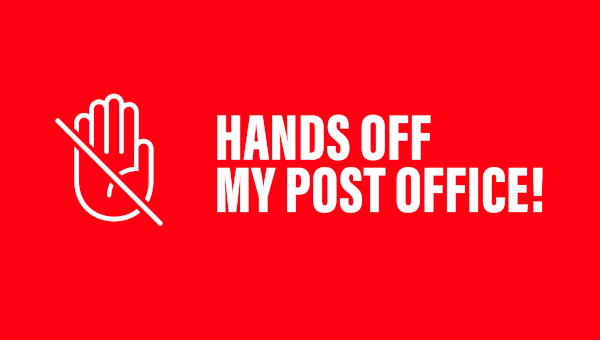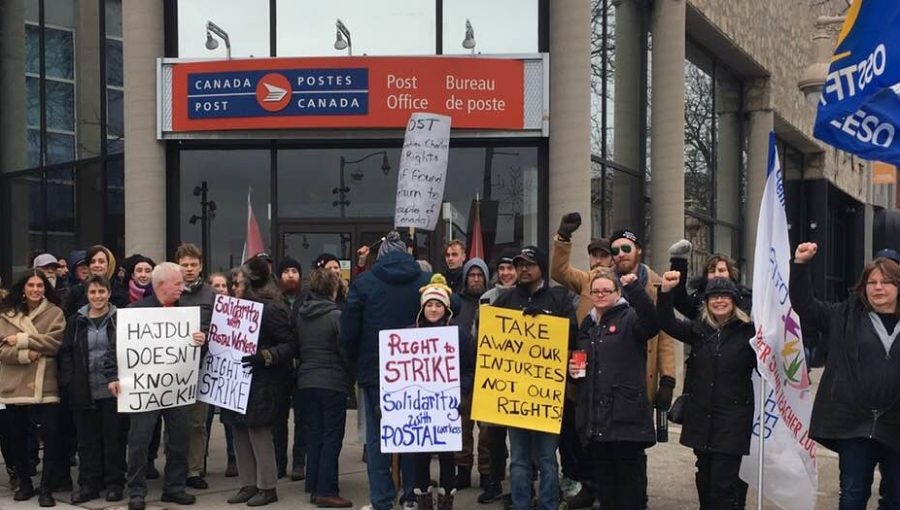CUPW Strike: Standing Up Against Misleading Claims
We felt it necessary to respond to [Canada Post president and CEO] Mr. Ettinger’s misleading “Dear Colleague” letter released this week. Mr. Ettinger is either misinformed or doesn’t fully grasp the situation; this crisis can be attributed to decisions made by his management group to undermine our rights and seize greater control.
The financial situation we face is the result of Canada Post management. They have been spending as if they have unlimited funds, with non-labour spending skyrocketing. According to their financial reports, from 2017 to 2023, non-labour spending increased by over one billion dollars per year, a 56.5% jump. During the same period, our wages only grew by 14.1%. Moreover, since May 2023 and continuing to at least May 2025, Canada Post has been exempt from contributing to our pensions. Our wages and benefits are not the issue here – it’s the mismanagement and overspending by Canada Post. The real question is, what are they spending all that money on?
Canada Post’s 5-year plan initially allocated $4-billion to upgrade infrastructure in response to the surge in parcel growth during the pandemic. However, even after the parcel numbers stopped growing, they continued spending. Breaking it down, $4-billion over 5 years amounts to $800-million per year, which makes it no coincidence that they reported a $748-million loss for 2023.
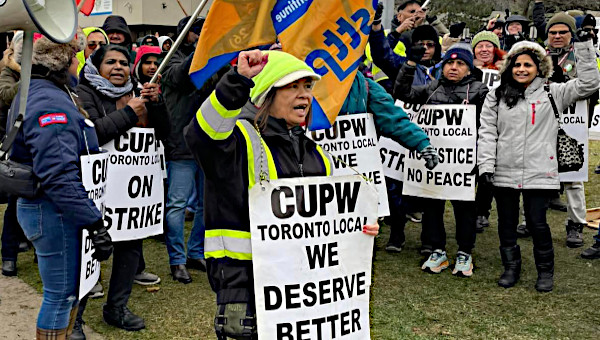
Mis-Management
If you plan a renovation on your home and then lose your income, would you still go through with it? Of course not. Yet, Canada Post continued to spend despite the stagnation, setting the stage for negotiations with CUPW. A financial loss supports their narrative. If they had paused spending on vehicles that are sitting idle in parking lots, postponed renovations, and delayed investments in IT, telematics, and cameras to watch you they wouldn’t be able to justify the rollbacks and changes they’re demanding due to the so-called “financial crisis.”
In 2022, Mr. Ettinger and his team informed Amazon that we lacked the capacity to handle their parcels, leading Amazon to take most of their business elsewhere. This decision alone accounts for the majority of the parcel volume loss. If they hadn’t driven Amazon away, there wouldn’t be a “crisis” to use as a weapon. Interestingly, Canada Post’s financial reports from 2018 and 2023 show the same total number of parcels (296 million). While parcel numbers were higher during the pandemic, it was unrealistic to expect that increase to continue post-pandemic. On the positive side, revenue for those same number of parcels grew by 39% since 2018, reaching $3.482-billion in 2023. We’re dealing with the same number of parcels with much higher revenue per parcel but have lost 30% of the market – creative accounting at its finest.
Canada Post is using “parcel market” numbers that include parcels that Amazon delivers themselves or through their subcontractor Intelcom. This is not the market; no other delivery company is beating us to those parcels. So why include Amazon parcels? Because it makes the situation appear worse than it really is! Everyone needs to be honest; this isn’t a game. In the video, Mr. Ettinger mentions they are selectively targeting certain parcels over others, highlighting the kind of irrational thinking coming from management.
Mr. Ettinger and his group need to take responsibility for several critical issues: the lack of proper sales staff, the drastic and disruptive changes to the delivery network, improper staffing, delays and non-delivery of mail, and their relentless pressure on front-line workers by hiring more supervisors, which has contributed to poor morale on the work floors. The costs associated with arbitration and STD appeals could also be avoided, but it’s clear their plan is more about controlling the workers and the union than saving money.
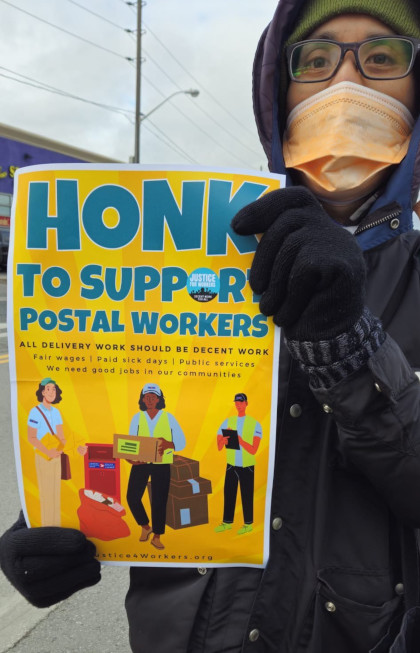
The fact that our competitors deliver directly to the door and not down the street like us and maintain direct customer contact might have the biggest impact on who customers choose for delivery. CUPW has suggested several initiatives to enhance Canada Post’s services, including expanding services to include postal banking and check-in services, developing an efficient e-commerce platform for small and medium-sized Canadian businesses and introducing new delivery services.
These measures could provide additional revenue streams, however, these proposals have yet to be adopted by Canada Post and they seem indifferent to anything outside of their plan. It’s difficult to believe that giving Canada Post management more flexibility will result in anything positive for workers; they use the flexibility they have to create more problems.
If they secure major concessions and the finances improve, they’ll say, “We told you so,” and give themselves bonuses. However, after spending billions over the past few years, the spending should decrease, improving the bottom line. This appears to be a manufactured crisis, with a preplanned solution designed to make their situation look better if everything goes according to their plan.
If you see Mr. Ettinger, be sure to tell him that you believe in improving customer service, not cutting services and front-line jobs and that you’ll stand up for what your household needs.
Shame on them. •
Canada’s 55,000 Postal Strikers Are Refusing to Throw New Hires Under the Bus
Danielle Smith
Roughly 55,000 postal workers in Canada are on strike, fighting to raise their wages, protect their work, and shape the future of Canada Post. They’ve been in negotiations since November 2023, after agreeing to a two-year contract extension in 2021 due to Covid.
“We definitely don’t want our jobs to become a race to the bottom,” said Tracey Langille, president of Canadian Union of Postal Workers Local 548 in Hamilton, Ontario. “We want solid jobs, living wages, decent benefits, and the ability to retire with dignity as well.”
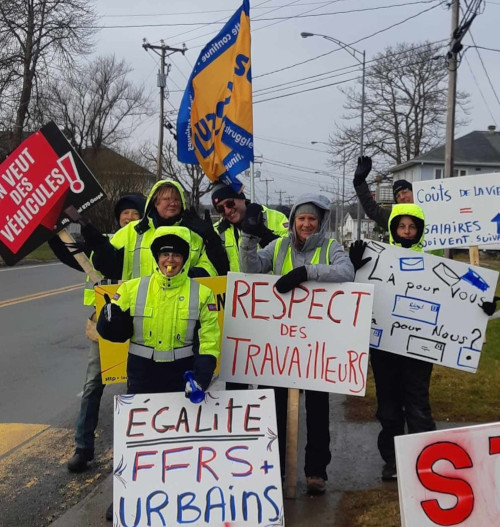
Unlike their counterparts in the U.S., most postal workers in Canada are covered by the same union. CUPW, which also represents other kinds of labourers like cleaners and warehouse workers, has two bargaining units of postal workers: one is the Rural and Suburban Mail Carriers, and the other is the Urban Operations.
In late October, CUPW announced that both of those units had voted overwhelmingly in favor of striking if there wasn’t enough movement from Canada Post at the table. The workers ultimately walked out on November 15, unsatisfied by management’s offers.
Canada Post then locked the workers out, following in the footsteps of port employers in British Columbia who locked out thousands of longshore workers earlier this month. CUPW and Canada Post are in mediation talks as the strike continues.
A Pile of Rollbacks
One of the major areas of concern for postal workers is their wages, which have lagged far behind inflation. James Ball, acting president of CUPW Local 730, said that starting wages in the union have increased only 6.7 percent since 2006, while workers lost about 50 percent of their purchasing power due to inflation in the same period.
The workers also say Canada Post is asking them to throw future hires under the bus. The company wants to make new hires wait a year before they can receive benefits, which are still worse than the ones that workers currently have, and to exclude them from the defined-benefit pension plan.
Craig Dyer, the president of CUPW Local 126 in St. Johns, said that Canada Post brought “a pile of rollbacks for our members” to the bargaining table. “These are things that we negotiated over our 50-year-plus history, and we weren’t going to stand for any rollbacks,” he said.
Another major issue is the weekend delivery model the company is pushing. While they aren’t opposed to making deliveries on the weekend for Canada Post to stay competitive, postal workers said, they want to protect the integrity of full-time and part-time schedules and not have the job become a part of the gig economy.
Government Intervention
When they last struck in 2018, Canadian postal workers did rotating strikes, targeting different cities across the country. This time, the workers wanted to flex their power by doing a general strike all at the same time, and their leadership listened, Dyer said.
In Canada, postal workers are legally allowed to strike as long as they provide 72 hours’ notice, which CUPW did on November 12. However, they can be legislated back to work by the Parliament, a move that was taken to end their most recent strikes in 2011 and 2018.
Postal workers see this legislation as interfering with their ability to use their leverage to negotiate better deals and fight for their rights. Langille said this year felt like the first time in a long time that the union had a chance to really negotiate.
The leftist New Democratic Party expressed support for the striking postal workers when they walked out and said that it will not support government intervention in the strike. Since the Liberal Party lacks a majority of seats in the Parliament, the NDP’s position means the Liberals likely won’t be able to pass any back-to-work legislation.
But the Canadian government has recently been putting strikers back to work without the legislature’s buy-in by invoking Section 107 of the Canada Labour Code to send the parties to binding arbitration. Canada’s Minister of Labour Steve MacKinnon used Section 107 to end strikes at the ports in British Columbia and Quebec.
Barry Eidlin, an associate professor of sociology at McGill University in Montreal, said that Canada’s federal government has basically “been talking out of both sides of its mouth in the past year.”
On the one hand, MacKinnon and the previous minister of labour have said repeatedly that the best deals are bargained at the table; but, on the other hand, they’ve essentially found “a sneaky way to order workers back to work” sometimes, Eidlin said.
Eidlin noted that the government might be hesitant to invoke Section 107 again, having already done so twice this year with the longshore workers in November and rail workers in August. However, given that strikes have sometimes been allowed to go on for weeks before being shut down, there is still some chance that a back-to-work order could come for the postal workers.
Having Some Fun With It
As the workers approach the end of the first week of the strike, the vibes on the picket line have remained high, according to local presidents.
In Dyer’s local, where it has been raining on and off for six days, picketers have received a lot of support from other unions as well as members of the public, who have been bringing them supplies like food and coffee. “It’s been absolutely amazing, because our battle is a battle for all workers, unionized or not,” Dyer said, preparing to head to another picket line where retirees wanted to drop off hot food.
Temperatures have been below freezing in Edmonton, Alberta, but the workers in Local 730 have still been on the picket line, making themselves visible and keeping warm around burn barrels. Some members have even brought soups and stews out to the line for their co-workers.
Langille said that the picket lines have been incredibly uniting, as Canada Post has made work more isolating. Members did karaoke on Saturday night at one of the plants in Hamilton and also expressed solidarity with members of the National Association of Letter Carriers in the U.S., who are also fighting for better wages and working conditions. A member of Local 548 who is a DJ has been traveling around to different lines with uplifting music.
Members of Local 856 in Winnipeg have been keeping spirits up with dance parties and karaoke, too. They’re planning a costume-themed day, complete with an inflatable dinosaur suit. Someone already dressed up as the Grinch with a sign around his neck: “CEO of Canada Post.”
Sean Tugby, the local president, said they’re “having some fun with it,” even though striking is hard work. “It is really difficult because the longer we’re on the line, these are our final paychecks before Christmas ourselves, and we’re going without, potentially, for our families,” Tugby said. “But we see the bigger picture, we realize what’s at stake, and we have to do what it takes in order to get to that result.”

The Future of Canada Post
Canada Post has pointed to $3-billion in losses since 2018 to paint a picture of financial crisis, a narrative that will sound familiar to postal workers in the U.S. But the company is trying to disguise investments as losses, the workers in CUPW say.
The corporation has spent $470-million on a new parcel sorting facility in Toronto, and announced a $30-million investment to expand a plant in Calgary. Canada Post has also started converting its 14.000 vehicles to electric, committing $1-billion to the project.
“If I personally do a $40,000 home renovation, my home is worth more, it’s not worth less,” said Tugby. “And they’re trying to sell it to the public and everybody else that they’re losing money.”
The workers further noted that their pension fund is overfunded, and everyone at the executive and supervisory levels at Canada Post received bonuses – while members of CUPW did not.
The path forward for Canada Post doesn’t have to be made through cuts, but could come from an expansion of services and diversification of revenue, the workers argue. Canada Post, which became a corporation owned by the government rather than a department of the government in 1981, is funded through its own business rather than through taxes.
One service that postal workers in Canada have championed for many years is a return of postal banking, which would both give Canada Post more revenue and help serve small communities that have been left behind by the banks.
Ball said the postal workers are making demands not only for their contract but also for the direction of Canada Post. He remembered how maternity leave became a national policy shortly after CUPW first demanded and won it.
“There’s a history of this union making significant changes in federal policy in the country,” Ball said. “And part of that we think we can harness into postal banking, to ensure both the post office stays profitable as well as bringing infrastructure across the country.” •


